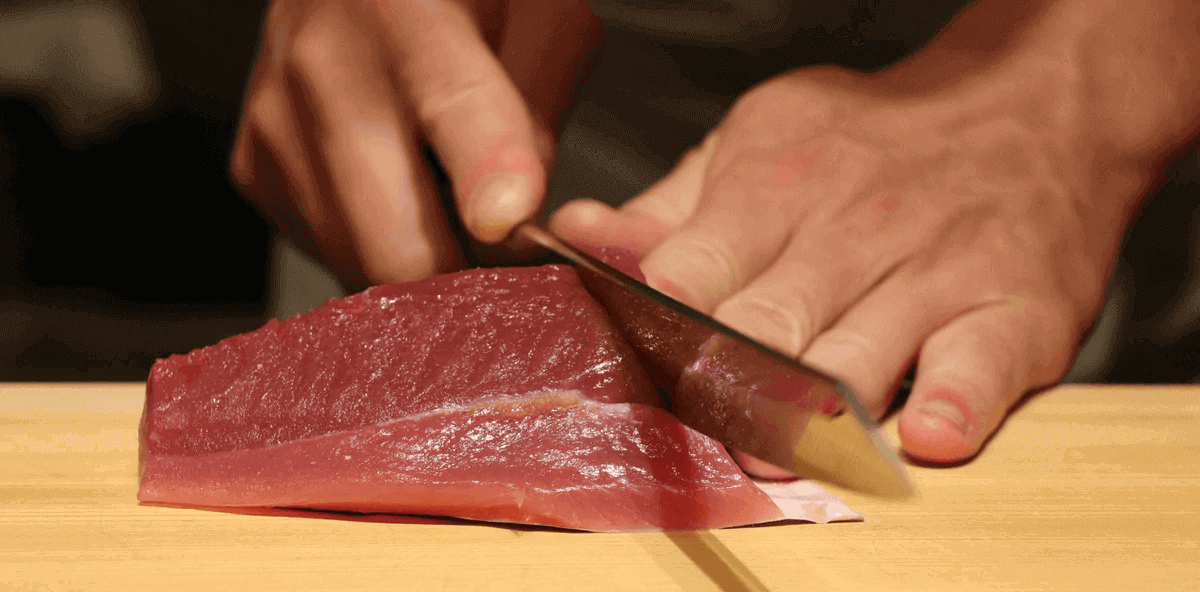Tuna cutting, a special art in Japan
A far cry from canned tuna or the dull sushi of all-you-can-eat buffets, tuna in Japan is an institution.
In the Shinjuku district of Tokyo, not far from the Shinjuku subway station, is Maguro Shoten (まぐろ商店) – literally "tuna shop" – a restaurant located in the basement of one of the buildings in the district.
This restaurant is an izakaya (居酒屋) type, the equivalent of our brasseries. It offers a whole range of tuna specialties, especially nigirizushi (our "classic" sushi) and sashimi, slices of raw fish.
A whole bluefin tuna cut every day
This restaurant has the particularity of cutting a whole tuna every evening at 8 p.m. in a show orchestrated by two chefs. They explain step by step the cutting of the fish and the different pieces that are removed from it.
The entire show is in Japanese, so it's hard for tourists to grasp all the information, but the demonstration is impressive nonetheless. Weighing several dozen kilos, the fish is gigantic, and it's easy to understand how Maguro Shoten manages to feed all his customers with just one fish a day.

Presented to the public, the tuna is already gutted, and the cooks begin cutting it by slicing off the tail, fins and head. The body, which constitutes the entire edible flesh, is then sliced into four large sections presented as trophies to the public, who are salivating in advance.


Everything is good in tuna
Once the fish is completely defleshed, one of the cooks then uses a spoon to scrape the remaining flesh along the main bone. That's how fresh and tender the flesh is! Served in a bowl, these last remains of the animal are then won by two customers who have beaten the chefs at jankenpon (じゃんけんぽん), the Japanese rock-paper-scissors.
The bone is then broken in order to extract the collagen contained in the cartilage. In the form of a large viscous drop, this liquid is not consumed for its taste, but to give elasticity to the skin: the beauty secret of Japanese women.
Several types of flesh
While our all-you-can-eat sushi restaurants only offer one type of tuna, the Japanese, who alone account for 80% of the world's consumption of bluefin tuna, distinguish different qualities of meat with different nuances.

Maguro Shoten serves plates of three pairs of nigirizushi made from three different qualities of flesh. We find the classic red flesh that we know and that in Japanese is called akami (赤身), which can be translated as "lean". Then come the intermediate quality pieces, fatter and lighter, called chūtoro (中トロ). And finally, the fattiest part and considered the best in taste (but also the most expensive), is the ōtoro (大トロ), a paler pink and rich in umami (うまみ), the savory taste of "come back for more".

An endangered species
Behind the tasty gastronomy lies an ecological disaster: in 2000, animal rights groups were alarmed by the overfishing of bluefin tuna and the collapse of their populations in the Atlantic and Mediterranean. Unfortunately, under the powerful lobbying of Japan, a majority of countries refused to include bluefin tuna on the list of endangered species .
However, these debates have led to a reduction in fishing quotas from 28,500 tonnes to 12,900 tonnes per year. It will take years to see whether this decision will have the expected beneficial effects and whether we will still be able to enjoy bluefin tuna. Wait and see .
Versatile and efficient, Japanese fish knives not only excel in the kitchen, but also prove to be the ideal tools for your fishing adventures, ensuring precise and efficient cutting every time.
Source: Konbini
kaitsuko - Kaitsuko France







The best Japanese restaurants in Paris